
A | B | C | D | E | F | G | H | CH | I | J | K | L | M | N | O | P | Q | R | S | T | U | V | W | X | Y | Z | 0 | 1 | 2 | 3 | 4 | 5 | 6 | 7 | 8 | 9
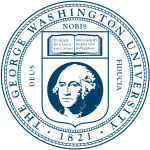 | |
Former names | Columbian College (1821–1873) Columbian University (1873–1904) |
|---|---|
| Motto | Latin: Deus Nobis Fiducia |
Motto in English | "God is Our Trust"[1] |
| Type | Private federally chartered research university |
| Established | February 9, 1821 |
| Accreditation | MSCHE |
Academic affiliations | |
| Endowment | $2.8 billion (2024)[2] |
| President | Ellen Granberg |
| Provost | Christopher Bracey |
Academic staff | 2,663 |
| Students | 26,457 (2021)[3] |
| Undergraduates | 11,502 (2021)[3] |
| Postgraduates | 14,955 (2021)[3] |
| Location | , U.S. |
| Campus | Large city, 43 acres (17 ha)[4] |
| Newspaper | The GW Hatchet |
| Colors | Buff and blue[5] |
| Nickname | Revolutionaries |
Sporting affiliations | |
| Mascot | George[6] |
| Website | www |
 | |
The George Washington University (GW or GWU) is a private federally-chartered research university in Washington, D.C. Originally named Columbian College, it was chartered in 1821 as Washington, D.C.'s first university by the United States Congress. GW is one of nation's six federally chartered universities.[7][8]
GW is classified among "R1: Doctoral Universities – Very High Research Activity."[9] It is the only member of the Association of American Universities in Washington, D.C..[10] The university offers degree programs in seventy-one disciplines, enrolling around 11,500 undergraduate and 15,000 graduate students.[11] The school's athletic teams, the George Washington Revolutionaries, play in the NCAA Division I Atlantic 10 Conference. GW also annually hosts numerous political events, including the World Bank and International Monetary Fund's Annual Meetings.[12]
Many notable individuals have served as trustees, such as Alexander Graham Bell and presidents John Quincy Adams and Ulysses S. Grant.[13] Notable alumni, faculty, and affiliates include 16 foreign heads of state or government, 28 United States senators, 27 United States governors, 18 U.S. Cabinet members, five Nobel laureates, two Olympic medalists, two Academy Award winners, and a Golden Globe winner.[14] GW has over 1,100 active alumni in the U.S. Foreign Service and is one of the largest feeder schools for the diplomatic corps.[15]
History
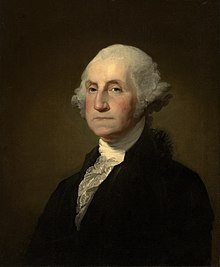
Founding
The first President of the United States, George Washington, long favored the establishment of a university in a central part of the United States.[16] He wrote to the U.S. Congress and others in favor of it, and envisioned it would be in a central part of D.C., stating he hoped the university would educate the most promising students from across the country while reaping the benefits of the nation's capital.[16] Washington included a bequest of his shares in the Potomac Company in his last will and testament, though the shares lost their value and no educational institution ever benefited from them.[17][18] His desire was shared and encouraged after his death by Presidents Thomas Jefferson and James Madison, and they expressed the need to carry out Washington's plans.[19] Finally, in 1821 the Baptist missionary and leading minister Luther Rice secured funds from James Monroe, John Quincy Adams, John C. Calhoun and other benefactors for a college to educate citizens from throughout the young nation in Washington, D.C. A large building was constructed on College Hill, which is now known as Meridian Hill, and on February 9, 1821, President Monroe approved the congressional charter creating the non-denominational Columbian College.[20] Washingtonians, Congress and the academic community celebrated this new institution as the fulfillment of Washington's vision.[17] The first commencement in 1824 was considered an important event for the young city of Washington, D.C. In attendance were President Monroe, John C. Calhoun, Henry Clay, the Marquis de Lafayette and other dignitaries.[21]
GW, like much of Washington, D.C., traces many of its origins back to the Freemasons. The Bible that the President of the George Washington University uses to swear an oath on upon inauguration is the Bible of Freemason George Washington. Freemasonry symbols are prominently displayed throughout the campus including the foundation stones of many of the university buildings.[22]

19th century
During this period most of the students came from the South, and as the Civil War broke out many left their studies to fight. However, the college was still fractured, as Professor of Anatomy since 1854, A.Y.P. Garnett, left for the South to serve as Jefferson Davis' physician and Robert King Stone stayed in Washington to serve as the physician to Abraham Lincoln. The college was temporarily turned into a Union military camp during this time. Poet Walt Whitman worked at this camp while visiting his wounded brother.[23] Following the war, in 1873, Columbian College became the Columbian University and moved to an urban downtown location centered on 15th and H streets.[24]
20th century
Columbian University was renamed The George Washington University in 1904 after an agreement with the George Washington Memorial Association.[25] In honor of George Washington, funds from the memorial association were donated to construct Lisner Auditorium.[26] The university moved its principal operations to the D.C. neighborhood of Foggy Bottom in 1912.[27]
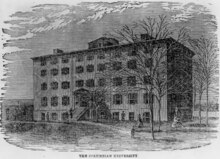
Many of the colleges of the George Washington University are notable for their age and history. The law school is the oldest law school in the District of Columbia.[28] The medical school is the 11th oldest medical school in the nation and the first established in the nation's capital.[29] The Columbian College was founded in 1821 and is the oldest unit of the university. The Elliott School of International Affairs was formalized in 1898.[30]
In the 1930s, the university was a major center for theoretical physics. The cosmologist George Gamow produced critical work on the Big Bang theory at GW in the 1930s and 1940s. In one of the most important moments in the 20th century, Niels Bohr announced that Otto Hahn had successfully split the atom on January 26, 1939, at the Fifth Washington Conference on theoretical physics in the Hall of Government.[31]
During the Vietnam War era, Thurston Hall, an undergraduate dormitory housing 1,116 students[32] was a staging ground for student anti-war Demonstrations. (At 1900 F Street NW, the building is 3 blocks from the White House.)
| College/School | Year founded |
| Arts and Sciences | 1821 |
| Medicine | 1824 |
| Law | 1865 |
| Engineering | 1884 |
| Arts and Design | 1878 |
| International Affairs | 1898 |
| Education and Human Development | 1909 |
| Business | 1928 |
| Media and Public Affairs | 1938 |
| Political Management | 1987 |
| Public Health | 1997 |
| Professional Studies | 2001 |
| Public Policy and Public Administration | 2003 |
| Nursing | 2010 |
In 1996, the university purchased the Mount Vernon College for Women in the city's Palisades neighborhood that became the school's coeducational Mount Vernon Campus. The campus was first utilized in 1997 for women only but became co-educational in a matter of years.[citation needed] The Mount Vernon campus is now totally integrated into the GW community, serving as a complement to the Foggy Bottom campus. In 1999, GW hosted the Town Hall with President Clinton, the first presidential town hall to ever be webcast live.
21st century

In December 2006, the university appointed Johns Hopkins University provost Steven Knapp as the next President of the George Washington University, and his presidency began August 1, 2007.[33] In 2017, Thomas LeBlanc, provost of the University of Miami, was named the President of the George Washington University.
In July 2020, the university began forming special committees to look at possible name changes to an on-campus building and the school moniker. In a statement on the university's website, George Washington University President Thomas LeBlanc said one of the panels would examine the Colonials moniker, which critics said conjured up racism, violence, and genocide. The Colonials name was officially retired in 2022 and the new nickname "Revolutionaries" was announced the following year.[34] Another panel looked into renaming the Marvin Center which was named after former school President Cloyd Heck Marvin, a segregationist.[35] In January 2022, LeBlanc was succeeded by former Washington University in St. Louis Chancellor Mark S. Wrighton as interim university president.[36] One year later in January 2023, the university named Ellen Granberg as the new president, with a start date of July 1, 2023.
Campuses
GW has three fully integrated campuses in the Washington, D.C. area. These are the Foggy Bottom Campus, the Mount Vernon Campus, and the Virginia Science and Technology Campus. The Foggy Bottom Campus houses the vast majority of academic programming. Residence halls exist on the Foggy Bottom and Mount Vernon campuses.
The GW library system contains the Gelman Library,[37] the Himmelfarb Health Sciences Library,[38] the Burns Law Library,[39] Eckles Library (named for Charles Ellison Eckles and Anita Heurich Eckles),[40][41] and the Virginia Science and Technology Library.[42] The GW Library System is a constituent member of the Washington Research Library Consortium, which allows for resource sharing among the university libraries of the Washington metropolitan area.
Foggy Bottom


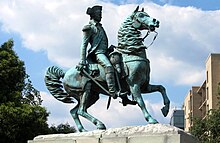




The main GW campus consists of 43 acres (170,000 m2) in historic Foggy Bottom and is located a few blocks from the White House, the World Bank, the International Monetary Fund, State Department and the National Mall. Barring a few outlying buildings, the boundaries of campus are delineated by (running clockwise from Washington Circle) Pennsylvania Avenue, 19th Street, E Street, Virginia Avenue, 24th Street, and New Hampshire Avenue. The university owns much of the property in Foggy Bottom and leases it to various tenants, including the World Bank and the International Monetary Fund. Other institutions in proximity include the U.S. State Department, the Kennedy Center, the U.S. Institute of Peace, the Watergate complex, and embassies of Bosnia and Herzegovina, Mexico, Saudi Arabia, Spain, and Uruguay. The University Yard is the main open space and historic heart of the university. Along with George Washington's main library, Gelman Library, it constitutes the hub of the main campus. The seven-story Gelman Library building contains over two million volumes and is constructed in the Brutalist architectural style of the 1970s. It features a concrete façade punctuated by windows that are divided by projecting vertical slabs. For most of the year, parts of the library are open 24 hours a day, seven days per week for use by students, faculty, and staff. The library's seventh floor includes the Special Collections Research Center, National Security Archives, Global Resources Center, and Kiev Library.
The National Security Archives (NSA) is a research institution that publishes declassified U.S. government files concerning selected topics of American foreign policy. It was a National Security Archive Freedom of Information Act request that eventually made the Central Intelligence Agency's so-called "Family Jewels" public.[43]
Close to the library is Lisner Auditorium and a large open area between them is known as Kogan Plaza. Southeast of the plaza and located near Monroe Hall and Hall of Government is the Monroe Court, a landscaped area with a large fountain. The Foggy Bottom–GW Washington Metro station is located at the intersection of 23rd and I Streets NW due south of Washington Circle, and provides access to the Orange, Blue and Silver lines. The University Hospital is located next to the Metro station entrance.[44][45][46]
The Foggy Bottom campus contains most of the residence halls in which GW students live. The most notable include Shenkman Hall, Thurston Hall, Madison Hall, Potomac House, Fulbright Hall, Mitchell Hall, Munson Hall, Jacqueline Bouvier Kennedy Onassis Hall, Phillip Amsterdam Hall, Guthridge Hall, Madison Hall, Townhouse Row, South Hall, and the newest, District House, which opened in 2016.
In late 2007, construction began on a large mixed-use residential, office and retail development located on the site of the old GW Hospital (Square 54) and just east of the Foggy Bottom–GW Metrorail station. It was the second-largest undeveloped lot in the District of Columbia at the time of initial construction activity.[47] In 2014, the university assumed ownership of the Corcoran Gallery of Art, the oldest private art museum in Washington, D.C. and independent college of art and design. The college of art and design became The Corcoran School of the Arts and Design under the Columbian College of Arts and Sciences. The National Gallery of Art will acquire many of the 17,000 pieces of art from the Corcoran and the rest will be donated to other museums around the country.[48] In May 2014, GW opened the Milken Institute School of Public Health, a nine-story building that received LEED certification for sustainability features including a green roof, rainwater collection system, and special heating and air conditioning technologies that helps mass air displacement.[49] The Textile Museum reopened to the public in March 2015 after the institution merged with the university in 2011 and closed it for renovations two years later.[50]
Mount Vernon
In 1996, the university purchased the Mount Vernon College for Women in the city's Palisades neighborhood that became the school's coeducational Mount Vernon Campus. Initially, the Mount Vernon Campus remained exclusively a women's college until 1999 when GW changed its operations to a co-ed facility.[51] It was purchased so that the university could gain more space and valuable land for athletics, such as for the women's soccer team.[52] Now known as the Mount Vernon campus, it is totally integrated into the GW community, serving as a complement to the Foggy Bottom campus.[52] The campus has transportation systems connecting the students to the GW campus in Foggy Bottom. It also includes Eckles Library, six residence halls, Lloyd Gymnasium, The GW-Mount Vernon Athletic Complex and other various campus facilities.[53]
Virginia
The George Washington University also operates a research and graduate campus in Ashburn, Virginia (near Dulles International Airport) which was established in 1991. Starting with a donation of 50 acres (20 ha) from Robert H. Smith, the campus grew to 101 acres (41 ha) by 2010.[54] Besides graduate education, this campus also offers undergraduate education to students, including Health Science, Cybersecurity& Information Technology, and Nursing.[55]
Additionally, the university also operates several other graduate satellite education centers. These include the Alexandria Graduate Education Center in Alexandria, the Graduate Education Center in Arlington, and the Hampton Roads Center in Newport News. The Virginia Science and Technology Campus hosts research and educational partnerships with industry and government officials and offers more than 20 graduate degrees.[56]
The Virginia Science and Technology Campus is home to the first walkable solar-power sidewalk in the world. The project began in 2012 and was completed two years later, inaugurated in October 2014.[57]
Organization
George Washington University is governed by the GW Board of Trustees, the President of the George Washington University, provost, deans, and department chairs. The university employs over 6,000 faculty members, administrators, and support staff.[58] In 2007, Steven Knapp was named the university's sixteenth president.;[59] he had previously taught at the University of California, Berkeley and was later the provost at Johns Hopkins University. The current President of the George Washington University is Ellen Granberg. Ulysses S. Grant was a member of the Board of Trustees, and his Grandson, Ulysses S. Grant III, was Vice President of GW. John Quincy Adams was also a member of the board of trustees.
Schools and colleges
| Undergraduate & Graduate Schools of The George Washington University | |||||||
|---|---|---|---|---|---|---|---|
| Columbian College of Arts and Sciences |
School of Business | Elliott School of International Affairs |
Milken Institute School of Public Health |
School of Engineering and Applied Science | School of Nursing | School of Media and Public Affairs | |
| Graduate Schools of The George Washington University | |||||
|---|---|---|---|---|---|
| Graduate School of Political Management | Medical School | Law School | Graduate School of Education & Human Development | Trachtenberg School of Public Policy and Public Administration |
College of Professional Studies |
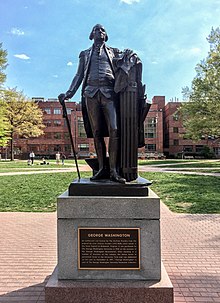



GW is organized into fourteen schools and colleges, each with a different dean and organization.[60] The Columbian College of Arts and Sciences was the original academic unit of the university.[61] The Medical School is the 11th oldest medical school in the nation and the first to open in the District of Columbia.[62] The Law School was also the first law school in the District of Columbia.[28] Each academic unit has a distinct identity within the broader university. The Graduate School of Political Management and the Corcoran School of the Arts and Design were organized outside of the university, later to join in 1987 and 2014, respectively.
Columbian College of Arts and Sciences
The Columbian College of Arts and Sciences (CCAS) is the oldest and largest college in the university. It was founded in 1821; at the beginning of the university's history, there was no distinction between this college and the university. The School of Media and Public Affairs (SMPA), and the Trachtenberg School of Public Policy and Public Administration (SPPPA) belong to this college, although they are run separately. The Columbian College was among the first American institutions to grant a Doctor of Philosophy (Ph.D.), in 1888.[63] The Columbian College is notable for its academic diversity, and offers a wide range of majors and courses of study.[63] The Columbian College contains the Trachtenberg School of Public Policy and Public Administration, the School of Media and Public Affairs, and the Corcoran School of the Arts and Design. The Columbian College is primarily housed in Philips Hall, Rome Hall, Smith Hall of Art, MPA Building, Monroe Hall, Hall of Government, 1922 F Street, Corcoran Hall, Bell Hall, Samson Hall, Lisner Hall, and many other places around campus. The college is also present on the Mount Vernon and Virginia Campuses.
Trachtenberg School of Public Policy and Public Administration
The Trachtenberg School of Public Policy and Public Administration is a graduate school in the Columbian College of Arts and Sciences.[64] Consistently ranked as one of the top Public Affairs Schools in the United States, it is ranked 11th nationwide by U.S. News & World Report. The Trachtenberg School offers Master of Public Policy, Master of Public Administration, and PhD degrees in Public Policy and Public Administration. The school works in partnership with the Elliott School of International Affairs, the School of Public Health and Health Services, and the Graduate School of Education & Human Development to offer a variety of concentrations for its graduates.
School of Media and Public Affairs
The School of Media and Public Affairs (SMPA), although run separately, belongs to the Columbian College of Arts in Sciences.[64] It offers two undergraduate degrees, Journalism and Mass Communication and Political Communication and a master's degree in Media and Public Affairs. It is housed in the same building as the Graduate School of Political Management. The Public Affairs Project at GW, part of SMPA, is responsible for the creation and production of the PBS special, Planet Forward. School of Media and Public Affairs (SMPA) was the first in the nation to offer a bachelor's degree in Political Communication. The program boasts a faculty of retired and current professionals – including CNN correspondents, journalists, political analysts, and campaign professionals. The school is consistently ranked in the top 10 programs in the nation.
Corcoran School of the Arts and Design
The Corcoran School of the Arts and Design is one of the oldest arts education institutions in the United States. It is a school of the Columbian College of Arts and Sciences.[64] It is housed in the Corcoran Gallery of Art, the oldest private cultural institution in Washington, D.C.
Formerly an independent institution, known as the Corcoran College of Art and Design, the institution later merged the college operations with the George Washington University. The school retained over 20 full-time faculty members, and the college will continue to function as a separate entity within the university. The school has a historic building facing the White House on 17th Street.
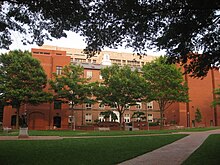
School of Business
The George Washington School of Business was established in 1928 with a $1 million gift by the Supreme Council of Scottish Rite Freemasonry Southern Jurisdiction.[65] On February 6, 2006, the chairman and CEO of FedEx, Frederick W. Smith, opened a new complex for the school called Ric and Dawn Duquès Hall, which today houses the business school along with the Norma Lee and Morton Funger Hall.[66]
As of January 2018[update], GW's undergraduate business program was ranked 42nd nationally and its International Business program was ranked ninth by U.S. News & World Report.[67]
School of Medicine and Health Sciences
Founded in 1824, the School of Medicine and Health Sciences (SMHS), or simply the George Washington School of Medicine, was the first school of medicine in Washington, D.C.[68]
In 1981, George Washington University Hospital became the center of the national spotlight when President Ronald Reagan was rushed to the emergency room after an attempted assassination.
GW Hospital's emergency department was later renamed the Ronald Reagan Institute of Emergency Medicine. Other politicians, such as former Vice President Dick Cheney, come to GW for routine and emergency procedures.[69] Cheney and wife Lynne Cheney helped to start the Richard B. and Lynne V. Cheney Cardiovascular Institute in 2006. Others notable patients include former First Lady Laura Bush, who was treated for a pinched nerve.

SMHS is primarily housed in the GW Hospital, Ross Hall, and many other centers along K Street and throughout the city.
GW was once home to the George Washington Dental College, but this department would close in 1921 due to budget constraints.[70][71]
School of Engineering and Applied Science

The School of Engineering and Applied Science (SEAS) was founded on October 1, 1884, as the Corcoran Scientific School of Columbian University. The school separated from the Columbian College in 1962 and was one of the first to accept women for degree candidacy in engineering.[72] The bazooka was invented at the SEAS in 1942.[73] The school moved into the new Science and Engineering Hall in D.C. in March 2015.[74]
Elliott School of International Affairs
The Elliott School of International Affairs (ESIA) was founded in 1898, as the School of Comparative Jurisprudence and Diplomacy. Under President Lloyd Elliott, the school separated from Columbian College. On September 3, 2003, alumnus Colin Powell opened a new complex for this school at 1957 E Street NW in front of the Department of State.[75] As of February 2015[update], its undergraduate program was ranked eighth globally by Foreign Policy magazine, while the graduate program is currently ranked seventh in the world.[76] ESIA is primarily housed in Elliott Hall at 1957 E St.
School of Nursing
The history of nursing education at GW spans more than 100 years. In 2002, Jean Johnson, Ph.D., RN, FAAN, then senior associate dean for Health Sciences, met with the nursing faculty to assess GW's capacity to create GW's degree programs. The faculty moved forward to develop an MSN in the GW School of Medicine and Health Sciences with programs in adult nurse practitioner, family nurse practitioner, nursing leadership and management, and clinical research administration. The first MSN class was admitted in 2004.[77]
Meanwhile, approval was also obtained to develop a Department of Nursing Education. As the first and only chair of the department, Ellen Dawson, Ph.D., RN, ANP, led the MSN program to accreditation in time for the graduation of the first class in 2006. Also, she spearheaded the development of both the doctor of nursing practice (DNP) program and the 15-month (four consecutive semesters) accelerated second-degree bachelor of nursing science (ABSN) program located in Ashburn, VA. The first classes for these degrees were admitted in 2007 and 2009, respectively.[77] In 2010, the GW School of Nursing was re-established and is now the university's tenth academic institution, with Jean Johnson and Ellen Dawson as the founding deans.[77]
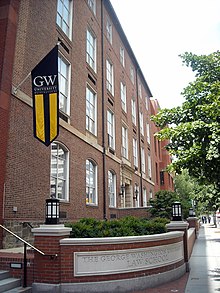
Law School
The George Washington University Law School was established in 1826 and is the oldest law school in the District of Columbia.[78] Supreme Court Justices Clarence Thomas, William Strong, David J. Brewer, Willis Van Devanter and John Marshall Harlan were among those who served on its faculty.[79][80] Chief Justice John Roberts, Justice Sonia Sotomayor, Justice Samuel Alito, and Justice Antonin Scalia presided over its moot court in 2006, 2007 and 2009, respectively.[81][82] The law school is located primarily on the east side of University Yard.
Graduate School of Education and Human Development
Although teacher education has been offered since the university's founding in 1904, the Graduate School of Education and Human Development officially started in 1909. The school turned its focus to graduate education in 1994.
College of Professional Studies
The George Washington University College of Professional Studies (CPS) was founded during the Trachtenberg Presidency.[83] The Graduate School of Political Management is included within the college.[84] CPS offers courses on the Foggy Bottom and Virginia campuses.
Graduate School of Political Management

The Graduate School of Political Management (GSPM) is an academic unit of the College of Professional Studies. GSPM offers graduate degrees in legislative affairs, political management, and other related disciplines. The current director is Lara Brown.[85]
Milken Institute School of Public Healthedit
Established in July 1997, and renamed in March 2014, the Milken Institute School of Public Health[86] brought together three longstanding university programs in the schools of medicine, business, and education that have since expanded substantially. Today, more than 900 students from nearly every U.S. state and more than 35 nations pursue undergraduate, graduate, and doctoral-level degrees in public health. Its student body is one of the most ethnically diverse among the nation's private schools of public health.
The School also offers an array of joint degree programs, allowing students to couple a Juris Doctor (JD) with the Master of Public Health (MPH), or to combine an MPH with a Doctor of Medicine (MD) or an MA in International Affairs. An MPH/Physician Assistant program, the first in the world, is available at the Milken Institute SPH, as is the opportunity to serve as a Peace Corps volunteer while pursuing an MPH.
Academicsedit
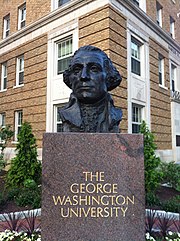

| Undergraduate | Graduate | U.S. (2010) | |
|---|---|---|---|
| White | 56.3% | 47.1% | 63.7% |
| Asian | 10.2% | 9.1% | 4.7% |
| Hispanic | 8.5% | 5.6% | 16.3% |
| Black | 5.9% | 11.0% | 12.2% |
| Two or More Races | 3.7% | 1.7% | 1.9% |
| American Indian | 0.1% | 0.3% | 0.7% |
| Pacific Islander | 0.1% | 0.2% | 0.2% |
| International | 10.0% | 17.7% | N/A |
| Unknown | 5.2% | 7.3% | N/A |
| Male | 43.6% | 41.5% | 49.2% |
| Female | 56.4% | 58.5% | 50.8% |

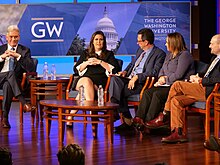

Admissionedit
GW is the largest higher education institution in Washington, D.C.[89] There are approximately 10,000 full-time undergraduates studying at George Washington University, and 14,000 graduate students.[90] These students come from all 50 states and over 120 countries.[89] Nearly 900 students participate in GW's Study Abroad Programs each semester in 50 countries.[91] As of 2015[update], George Washington University no longer required the SAT and ACT test scores for applicants in order to boost the enrollment of disadvantaged students.[92]
GW tuition was guaranteed to remain at the freshman rate for up to ten continuous (full-time) semesters of undergraduate attendance at the university. GW no longer offers fixed tuition. The 2021–2022 academic year tuition rate was $59,780.[93] Students were awarded $308.1 million in financial-aid during the 2017–2018 academic year.[94] For the FY2011 cohort of students, the student loan default rate was 1.4, one of the lowest in the nation.[95] For the 2010–2011 school year, the freshman retention rate was 94.3%.[96][needs update] GW requires that students live on campus for their first two years of enrollment as undergraduates.[97] According to self-provided data by George Washington University, as of the 2011–2012 academic year, the acceptance rate for the Medical School was 3%, receiving 10,588 applications. GW Law School's acceptance was 23%, receiving 10,021 applications. GW's Undergraduate studies' acceptance rate was 32%, receiving 21,433 applications.[98] Admission to George Washington was at 43% for undergraduates in 2023.[99]
In September 2013, The GW Hatchet reported that the university had a need-aware admissions policy, even though it claimed to have a need-blind policy at the time. The university subsequently admitted that its admissions policy was, in fact, need-aware.[100]
Enrollmentedit
During the 2013–2014 academic year, there were 5,015 undergraduates enrolled in the Columbian College of Arts and Sciences, 2,005 in the Elliott School of International Affairs, 1,566 in the School of Business, 774 in the School of Engineering and Applied Science, 367 in the George Washington University School of Medicine and Health Sciences, 174 in the Milken Institute School of Public Health, and 153 in the School of Nursing.[101]
Zdroj:https://en.wikipedia.org?pojem=WRGW_(student_radio)
Text je dostupný za podmienok Creative Commons Attribution/Share-Alike License 3.0 Unported; prípadne za ďalších podmienok. Podrobnejšie informácie nájdete na stránke Podmienky použitia.
Antropológia
Aplikované vedy
Bibliometria
Dejiny vedy
Encyklopédie
Filozofia vedy
Forenzné vedy
Humanitné vedy
Knižničná veda
Kryogenika
Kryptológia
Kulturológia
Literárna veda
Medzidisciplinárne oblasti
Metódy kvantitatívnej analýzy
Metavedy
Metodika
Text je dostupný za podmienok Creative
Commons Attribution/Share-Alike License 3.0 Unported; prípadne za ďalších
podmienok.
Podrobnejšie informácie nájdete na stránke Podmienky
použitia.
www.astronomia.sk | www.biologia.sk | www.botanika.sk | www.dejiny.sk | www.economy.sk | www.elektrotechnika.sk | www.estetika.sk | www.farmakologia.sk | www.filozofia.sk | Fyzika | www.futurologia.sk | www.genetika.sk | www.chemia.sk | www.lingvistika.sk | www.politologia.sk | www.psychologia.sk | www.sexuologia.sk | www.sociologia.sk | www.veda.sk I www.zoologia.sk
